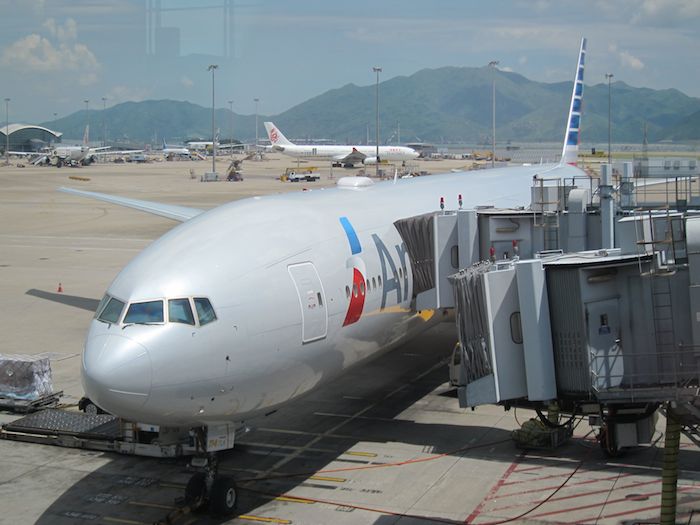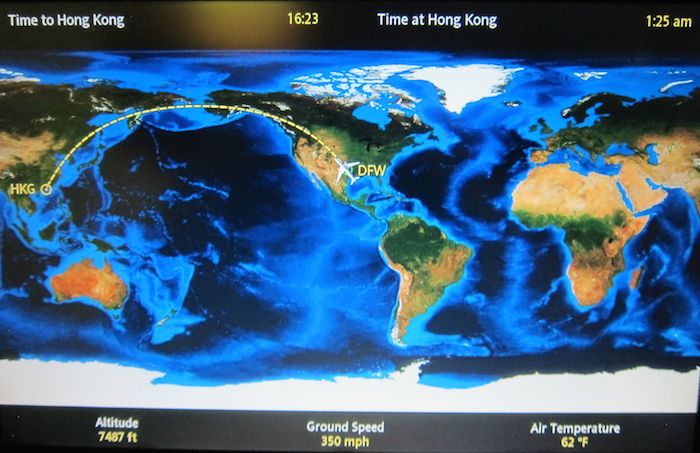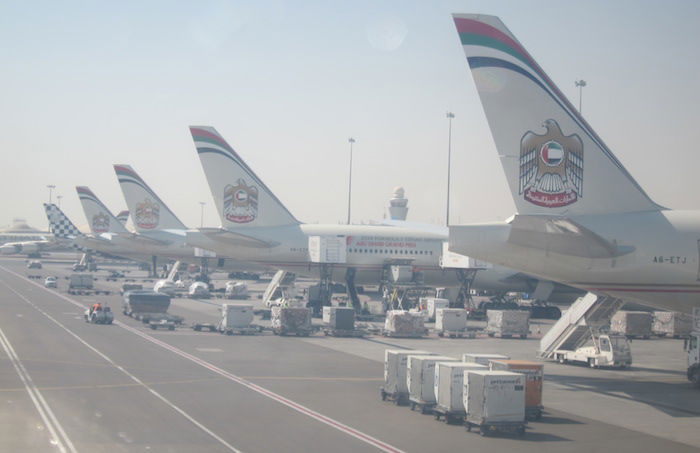The Centre For Aviation has an interesting article about American’s growth strategy in Asia, entitled “American Airlines’ triple play in greater China is part of long-haul rejuvenation, with more to come.” It’s well worth a read.
There’s nothing terribly shocking in the article, though there are some interesting tidbits. I guess I find this especially interesting because American is the US carrier I’m most loyal to and Asia is my favorite place to fly to, though unfortunately American and Asia have long been “incompatible.”
They’re finally slowly changing that, between the Dallas to Hong Kong/Shanghai routes that launched earlier in the year, in addition to the Dallas to Beijing route that is launching next year.

American Airlines 777-300ER in Hong Kong
So what does the article say?
First, it looks like American’s routes to Asia are for the most part loss-making and investments in the long term:
The growth is dampened by financial performance, with American CEO Doug Parker remarking American’s Asia services are loss-making and “investments for the long term”.
It’s worth remembering that the reason American was restricted on the most lucrative Asia routes for so long was because of their pilot contracts which prohibited such long flights, along with inefficient aircraft and an all around unsustainable cost structure. Most of these problems have been solved post-bankruptcy:
American considered a Dallas-Beijing route for new US-China route authorities in 2006, but the route was longer than American’s pilot union contract allowed.
Negotiations to operate the longer service did not produce a favorable outcome, with the union requesting conditions that affected the commercial viability of the service. However, bankruptcy restructuring allowed American to change its contracts in ways that now permit longer flights without the commercial restraints American previously experienced. This was also a factor delaying American’s entry into Hong Kong.
While I in theory understand why American’s Hong Kong flight originates in Dallas, it’s extremely difficult to turn a profit on ultra longhaul flights. Add in the fact that the plane sits on the ground in Hong Kong for 20 hours, and the prospects of profitability look even more grim. I’m told the primary reason for the flight timings is to facilitate connections to Latin America, though those are made more difficult by the requirement for visas in order to transit the US:
The US’ reluctance to offer transit visas does disadvantage American (and other US carriers) in the Asia-Latin America market. US carriers can offer more Latin American destinations than the Gulf carriers and shorter connections than European carriers, and they are often competitively priced.

Dallas to Hong Kong airshow
So how does Cathay Pacific feel about American’s new Dallas to Hong Kong route, given the added connecting traffic it’s potentially offering, and the fact that they codeshare? Well, Cathay’s website doesn’t show the American codeshare flight if searching flights just between Dallas and Hong Kong, while it does show it if searching with a connection. Add in the limited mileage earning, and the relationship is almost starting to look like the one between Delta and Korean Air:
Cathay’s website does not show its codeshare on American’s Hong Kong-Dallas service when ticketed non-stop, but does show it when booked as a connection.
Frequent flyer arrangements are limited, whereas American is closer to Cathay via the oneworld alliance, although Cathay was the one which pushed for restrictions on economy fare classes that are mileage accruable.
Not surprisingly, long term American wants to continue to expand with both new destinations and more routes to existing destinations. Most interesting though is that they’re eying another Hong Kong flight eventually, and for the time being aren’t interested in a fifth freedom route out of Hong Kong:
American’s growth in Asia is aimed around new cities (as seen with Hong Kong) and additional service to existing points (as seen with Dallas-Beijing/Shanghai). Hong Kong is likely to receive additional service at some point, with Mr Perhirin noting its initial 14 local staff, including 10 in sales, were not placed to support a single daily service indefinitely. But he cautions the short-term is focused around making the initial daily Dallas-Hong Kong service work, including building up ex-Hong Kong sales. United offers beyond flights from Hong Kong to Southeast Asia, but Mr Perhirin said it was pre-mature for American to consider fifth freedom services within Asia. (American’s aircraft has a nearly 20-hour layover in Hong Kong, but this is done for scheduling and for maintenance work in Hong Kong.)
Hoping for a new route to Australia/New Zealand? It looks like it’s not totally out of the question, though American’s agreement with Qantas is specifically based around them not operating their own flights to Australia and New Zealand. So something would need to change for that to happen:
American’s growth in Asia-Pacific is not necessarily confined to Asia. Although there are no immediate plans, service to Australia/New Zealand could be on the cards for American, although this could require changing American’s agreement with Qantas that was built (and approved by regulators) on the basis of American not serving Australia/New Zealand. Mr Perhirin does not offer much detail other than to say “You’ll see us be able to evaluate and implement ultra-long-haul growth in a manner we couldn’t” before.
Lastly, American is actually better positioned for expansion in the Middle East than the other two US legacy carriers, though we’ll see if it actually materializes:
With Asia addressed, there should be a strategic move on a Middle East hub. Where American fell behind in Asia, it has an opportunity to take the lead in the Middle East. American is growing its relationship with Etihad and Qatar while, Emirates, the world’s largest international airline, has made obvious overtures.
The three Gulf carriers see American’s position as having the largest domestic network, key for beyond gateway access. Another factor is that American has not set fire to bridges with Gulf carriers, unlike Delta and United – although CEO Doug Parker recently joined the other two CEOs in lobbying Washington to wind back the US open skies policies, with a specific goal of slowing the expansion of the Gulf carriers. American has otherwise intentionally been conservative, rather than dismissive, with the Middle East operators. It has more to gain by allying with (one or more of) them than opposing their entry.
That seems like a huge potential growth area for them, especially since they cut service to India a few years back.

Etihad planes at Abu Dhabi Airport
Bottom line
There’s nothing terribly shocking here. It’s nice to see American finally in a position to grow in Asia. Between the pilot contract restrictions being eliminated, a better cost structure, and the delivery of Boeing 787 and Airbus A350 aircraft coming up, I think we’ll be seeing quite a few new routes to Asia over the coming years.





@John If you fly Etihad they might run out of food, ☺
Lucky, you have a sick blog man.
I think it's a big "if" to Lucky's last statement...."if" there is not a downturn. Over a full cycle, DFW to Asia is just folly. LAX, ORD and JFK should be the bases. I've heard at least one foreign airline executive privately snicker about DFW, and have to imagine AA's US-based competitors are amused as well. Serve Asia out of DFW?! This is bull market decision-making whenever...
Lucky, you have a sick blog man.
I think it's a big "if" to Lucky's last statement...."if" there is not a downturn. Over a full cycle, DFW to Asia is just folly. LAX, ORD and JFK should be the bases. I've heard at least one foreign airline executive privately snicker about DFW, and have to imagine AA's US-based competitors are amused as well. Serve Asia out of DFW?! This is bull market decision-making whenever the next downturn strikes, this "investment" is going to be cut. LAX will stay but DFW is laughable. Just does not make sense for both passengers who have to back-track, and fuel economics...especially given most Asia-based carriers have far products that have cash-ticket pricing power over AA's premium cabins, which are filled with elites usually not paying cash fares for the seats they're in.
AA bean counters had some fantasy idea that they could pull ex-HKG traffic to Latin America via DFW. Well, that hasn't happened. Now they're changing their tune and calling it an "investment" in Asia. Just bad management. People would far rather connect on CX via LAX or JFK to Latam. Basing an Asia hub in DFW is asking for Asia route competitors like UA out of SFO, ORD and EWR, Delta out of Seattle, and frenemies like CX, to eat AA's lunch. As posted in Lucky's recent HKG-DFW thread on AA, J class pricing (10k USD, equivalent to CX HKG-JFK) is just ridiculous for those of us who don't post miles to AA and actually buy full cash fares, so we care about the product. There is no chance I'd pay the same price to fly AA premium class metal versus CX to North America or even connecting.
The competitive environment to Asia ex-North America is only going to get worse given CX is growing its North American presence. To the John guy above...Cathay launches Boston in early 2015. And some of the first destinations Cathay is expected to launch with its new A350s in the next 18 months are likely to include additional North American cities and frequencies. American is just enjoying the short-lived high of their restructuring; picking DFW as one of their Asia hubs, or as a showcase for their Asia "investment" or whatever they're calling it, shows their heads are still in the sand.
Using DFW as the focal point of the Asia service is surprising. As others have noted, the only part of the US that it serves well is the southeast. Connections to Latin America may work well but for the biggest markets in South America they have to compete against the gulf carriers and the asian carriers, couple that with the need for a transit visa and it seems like flying through DOH or DXB would...
Using DFW as the focal point of the Asia service is surprising. As others have noted, the only part of the US that it serves well is the southeast. Connections to Latin America may work well but for the biggest markets in South America they have to compete against the gulf carriers and the asian carriers, couple that with the need for a transit visa and it seems like flying through DOH or DXB would be easier. In some cases it's faster to fly from Asia to South America thru Australia. American is clearly trying to build up the connection between those markets though, right now their J fares ex-HKG flights to SCL are less than half the typical price range, and fares to GRU are cheaper than anyone else by at least 10%.
For west coast, east coast or upper midwest travelers it seems like there are too many other good options to/from Asia for AA to really compete.
Best made plans and all.....my basic question is why anyone flying in premium cabins (particulaly First Class) would pay the same $$ for the questionable, third-grade service of a North American airline versus the wonderful service and comforts offered on long-haul flights by truly international airlines? I tried it once - never again.
Great article from CAPA.
Lucky,
So, Boston to Hong Kong is $5484 on American and $5612 on Etihad. Is there any reason to go with AA other than existing loyalty/points? What incentive is there for a business traveler to go with AA vs the other Asian or Gulf airlines.
@ John -- Assuming miles don't matter and you don't mind flying the long way then I'd probably go with Etihad, yes.
@Ivan Y
Parker said the same thing about Asia being unprofitable before the launch of the DFW-HKG flight, so I'm guessing they are using that quote instead of it being a new quote specifically referencing the profitability of the DFW-China flights. That said, I have no doubt that their Asia routes are as unprofitable as ever.
DFW is poorly located for service to Asia. It's 3 flying hours further than SFO for most destinations.
AA simply doesn't have any good hub locations for Asia service.
Seeing as QF pulled out of AKL-LAX, it would be nice to see a 787 run AKL-DFW... pipe dream I know.
Hmmm... At least AA finally admitted what everyone's been suspecting about profitability of the route to HKG.
@ Lucky -- with 787 and A350 coming online, are you thinking airlines (esp. US airlines) will go to more direct routes internationally instead of routing via a partner hub? Seems to be heading that way. And is that going to create friction in alliances?
@ Ivan Y -- Absolutely do think so. After all, that's the biggest selling point of those planes.
It would be interesting to know AAs long term plans on this route. I'm with Lucky that they are going to have a hard time making money on this ultra-long haul flight particularly having to pay to park the plane in HK for 20 hours. The connections at DFW are strong but for someone coming from anywhere other than Texas, OK or the Southeastern USA, DFW is really out of the way. I just dont...
It would be interesting to know AAs long term plans on this route. I'm with Lucky that they are going to have a hard time making money on this ultra-long haul flight particularly having to pay to park the plane in HK for 20 hours. The connections at DFW are strong but for someone coming from anywhere other than Texas, OK or the Southeastern USA, DFW is really out of the way. I just dont see business travelers from anywhere other than Texas or the Southeastern USA flying to Dallas on the way to Asia. Anyone who cares about time in BOS, NYC, Philly or DC is either going to fly direct or get an on the way connection in Seoul or Tokyo. From the West Coast it makes even less sense to fly all the way back to Dallas. It just seems like they need business travelers to make this route work and yet the geography of this route is so unappealing for most of the affluent American markets. Perhaps they think there is enough of a market in Texas to support this route or hope that business flyers wont mind spending an extra 2-6 hours in the air to route through Texas.
Who writes these articles (I mean the Center for Aviation!)? American is trying to establish itself in China - Beijing, HK, etc. That's natural since China is the biggest economy in Asia (and in the world almost) and they are very late to the game. But that's not an Asia strategy - maybe a springboard into some future and as yet undefined Asia strategy. American doesn't fly to Indonesia, or Singapore, or anywhere else in...
Who writes these articles (I mean the Center for Aviation!)? American is trying to establish itself in China - Beijing, HK, etc. That's natural since China is the biggest economy in Asia (and in the world almost) and they are very late to the game. But that's not an Asia strategy - maybe a springboard into some future and as yet undefined Asia strategy. American doesn't fly to Indonesia, or Singapore, or anywhere else in SE Asia. Part of that issue is geography (a hub in Dallas doesn't help). It doesn't fly to the Indian subcontinent (United's direct flights are always packed and priced much higher than connections), nor the Middle East. It doesn't have a flight to Istanbul or Tel Aviv (US Airways does). American is basically a US/Latin American/European carrier. It's going to be very hard for them to build, compete and be profitable to Asia. Just wait till the next economic downturn - they will not be able to invest for the long haul.
As a resident of the Dallas area, It is very exciting to hear about American's plans for Dallas. I just hope they continue to grow out of Dallas versus their other hubs! Though to me it does not completely make sense for them to grow so many Asian Routes out of Dallas. It seems like Chicago would be a better option for them.
It may not be ultra-Long haul but united has very short turn around times on their ewr-tlv route. I'm guessing the 20 hours has more to with scheduling than anything else in the same way that Iceland air keeps their 757's on the ground in Seattle for example for long periods of time.
Think there's any chance of DFW-HKG being operated by a 787 in the future? A 787-8 could make the trip distance-wise ...
@ Justin -- I definitely do. Or perhaps if the route does well, I wouldn't be surprised if their second HKG route is operated by a 787 instead.
It will be interesting to see what happens between Qantas and American, Qantas seems to be getting more in bed with people outside OW than inside of it, so American might just be hedging for an eventual Qantas departure from OW and being ready to step in.